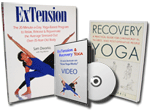"Flexibility is simply NOT a requirement
to successfully practice this program.
Enhanced flexibility, strength and endurance
are but a result of an appropriate yoga practice."
The usual way of doing a standing forward bend is to round your back,  bend over with your legs straight, and trying to bring your head to your knees -or- trying to touch your toes. Unless you are very flexible, this can strain your back or lead to other injury.
bend over with your legs straight, and trying to bring your head to your knees -or- trying to touch your toes. Unless you are very flexible, this can strain your back or lead to other injury.
There is a much safer and more effective way to do yoga. This book, ExTension, shows three models for each exercise and shows, regardless of your level of flexibility, how to safely and successfully practice yoga.
Find the body type below that most closely matches your body style:
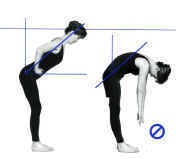 This body type is characterized as "taut." In order for this person to experience the "perfect" yoga posture, it is important that she not create strain by trying to do a forward bend. (Review The Operative Word is TOWARD). Instead, when she keeps her torso about 45 degrees from vertical, her back stays long and her head remains in a "neutral" position. (Review Principle 6 in The Seven Principles of a Highly Effective Yoga Practice). Keeping her hands on her hips, with knees slightly bent, she will feel the action, or stretch, in her hamstrings and not the tendons behind her knees. (Review The All Important Fascia for an in depth discussion of the implications of inappropriate tendon stretching).
This body type is characterized as "taut." In order for this person to experience the "perfect" yoga posture, it is important that she not create strain by trying to do a forward bend. (Review The Operative Word is TOWARD). Instead, when she keeps her torso about 45 degrees from vertical, her back stays long and her head remains in a "neutral" position. (Review Principle 6 in The Seven Principles of a Highly Effective Yoga Practice). Keeping her hands on her hips, with knees slightly bent, she will feel the action, or stretch, in her hamstrings and not the tendons behind her knees. (Review The All Important Fascia for an in depth discussion of the implications of inappropriate tendon stretching).
This body is characterized as: "Moderate."
Her body is about 60 degrees from vertical and her back stays long with the tailbone gently lifting upward. With hands on her hips and knees slightly bent, the stretch will stay away from the back of her knees and she will feel the correct stretch primarily in her hamstrings. What is absolutely crucial to understand, is that a gentle "action" is felt directly in the hamstrings and not behind the knees or in her back. The operative word therefore, is "toward" the floor, not "to" the floor. In ExTension Yoga, "less done correctly always gets you more."
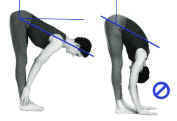 This body is characterized as "Supple."
This body is characterized as "Supple."
His body is 90 degrees or more to the floor--his ribs are extend away from hips. With reasonably straight knees (but not so straight that the "action" is felt behind the knees, the torso and head are in a straight line similar to the alignment of the torso and neck if he were standing "on the plumb."
Let's now do an experiment: The usual way of doing a standing forward bend is simply rounding your back, bending over with your legs straight, and trying to touch your toes. Do it now, and notice what you feel. Go down just until you feel a pull in your legs, your back, or both. Keep your legs straight. If you're really flexible, you may have to grab your ankles and pull your head toward your feet as seen below. But please be cautious and avoid pulling into any significant pain.
Pay particular attention to where you feel the stretch in your legs and in your back. For most people, it will be behind the knees or in the Achilles tendon in the calves. And quite a few people feel it in their lower back. In addition, I have a most important question; something that is extremely important, yet, it is something that most people never thing about. As you are folded over, how does your breathing feel? As open and free as when you are standing upright or has your breathing become somewhat inhibited?
Come up from your forward bend by bending your knees as you round up, and relax. Then please read on.
Preparation and Proofs: A Little Anatomy
Let me explain what's wrong with the usual Forward Bend. Bend your right arm and “make a muscle.” Now grab the thickest part of that muscle, your biceps, with the fingers of your left hand [See below left]. Feel how fleshy that area — the belly of a muscle is? That's because it's full of blood, which means it's very resilient and able to recover quickly if injured or overstretched. Next, move your fingers closer to the elbow and notice how the belly of the muscle changes, tapers down, and becomes small and hard [See below right].
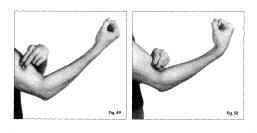 The muscle is merging into tendon, which in turn attaches to bone. All of your muscles, including the hamstrings, do the same thing. If you isolate a stretch in the belly of a muscle, you will enhance your flexibility without hurting yourself. But if you take the stretch into tendons, you may cause irritation which can lead to tendinitis. If you're young and healthy, a tendinitis might heal within three to six weeks; as you get older, however, it usually takes longer. If you stretch deeply into your joints, you could overstretch ligaments; if a ligament is injured, surgery is usually your only recourse.
The muscle is merging into tendon, which in turn attaches to bone. All of your muscles, including the hamstrings, do the same thing. If you isolate a stretch in the belly of a muscle, you will enhance your flexibility without hurting yourself. But if you take the stretch into tendons, you may cause irritation which can lead to tendinitis. If you're young and healthy, a tendinitis might heal within three to six weeks; as you get older, however, it usually takes longer. If you stretch deeply into your joints, you could overstretch ligaments; if a ligament is injured, surgery is usually your only recourse.
Turn again to Bachin's “Muscular System” on page 188 (web surfers can click here, then hit your back button to return) . Look at the lower back. It looks just like tendon tissue, not muscle tissue —dense, light-colored, with not much blood circulation, and therefore similarly tough to heal if injured or overstressed.
To summarize, when you keep your legs locked straight and round your back trying to touch the floor, you're actually stretching tendon and the denser tissues of the lower back instead of hamstring muscle. Since the areas of the low back and knee tendons are so difficult to heal when injured, the goal of ExTension is to stretch your body appropriately by isolating, at least initially, the action of each exercise in muscle, not tendon or low back tissue. You also want to avoid bouncing as you stretch (called ballistic stretching), which often leads to muscle, tendon, or ligament injuries.
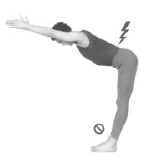 I want to show you two more things about the traditional standing Forward Bend. Raise your arms up overhead, then bend forward from your waist with a flat back [Fig. 51]. As you fold over, can you feel a strain in your lower back? That's because as your arms move overhead, the “load” to your lower back increases by at least four times than when your hands stay on your hips. Look at the arrow in Figure 51 (page 67). That's where the entire load from this exercise is taken. If you have a weak back, a current injury, or predisposition to injury, a chain reaction of pain-contraction-pain sets in. There is no way to correct this —just don't do it.
I want to show you two more things about the traditional standing Forward Bend. Raise your arms up overhead, then bend forward from your waist with a flat back [Fig. 51]. As you fold over, can you feel a strain in your lower back? That's because as your arms move overhead, the “load” to your lower back increases by at least four times than when your hands stay on your hips. Look at the arrow in Figure 51 (page 67). That's where the entire load from this exercise is taken. If you have a weak back, a current injury, or predisposition to injury, a chain reaction of pain-contraction-pain sets in. There is no way to correct this —just don't do it.
Come down into a traditional rounded-back Forward Bend one last time. Earlier, you learned that when you stand up straight, you can breathe more deeply than when you stand with a slump. You also learned in the ExTension Principles how important a deep breath is. In other words, you learned that exercises which inhibit your breath cannot be nearly as good for you as exercises that enhance your breath.
So, for the last time, go on now into the standing Forward Bend with a rounded back. Push down as low as you can. Not only will you experience discomfort behind your legs and perhaps in your lower back, but notice how inhibited your breath becomes. Then, bend your knees slightly and slowly stand up.Let's now explore how less gets you more (remember Principle #3?) by learning a better way of bending forward. This time, we are going to isolate the stretch (action) right in the center of your hamstrings.
First, stand upright, with your feet nearly parallel about two to three inches apart, weight balanced equally on both feet (forward and rear, left and right). Place your hands on your hips and extend your spine long. Center and relax your head on your neck by turning it side to side a few times. Now, keeping your knees slightly bent, slowly bend forward from your hips and without rounding your back.



The ExTension Forward Bend
Lift up on your sitting bones and tailbone (imagine you have duck feathers that you want to show off). Only go down as far as you need to in order to feel the action (a stretch) in the center of your hamstring muscles, not the tendons behind your knees. If you feel discomfort behind your knees or in your back, take your torso up higher, and then, if you still feel discomfort behind your knees, bend them a little more. You may only need to rotate slightly forward before you feel a hamstring stretch; if so, you don't need to go down any lower.
Breathing deeply, lengthen your spine even further by feeling as if your belly is growing longer, your lower back naturally arching more (you must be careful here because overarching your back will cause pain). Your shoulders should move higher from the floor when your spine grows longer. This movement should increase the stretch of your hamstrings.
Notice a few things while you hold this posture as compared to before when you rounded your back down and dropped your hands toward the floor. Now you can isolate the stretch in the center of your hamstrings. Now you can breathe much more deeply. Now you don't feel that discomfort or pain behind your knees or in your back. And now you are actually doing less movement because you are much farther from the floor. Less, when done correctly, will always bring you more — less pain and discomfort and more accurate stretching. You're going to prove this over and over as you learn these exercises.
When you're ready to come out of this standing Forward Bend, don't just lift your shoulders to straighten up; this crunches your spine. Rather, think about initiating the rotation from your hips and pelvis, not from your shoulders. Move your whole torso as a single unit, keeping the integrity of your long spine and natural lumbar curve. Keep your knees slightly bent, your hands on your hips, and inhale on the way up to your standing position (Mountain pose). Then exhale, relax, and quietly deep breathe.
![]()
Originally published:
- In English: Simon and Schuster/Poseidon Press, New York, ISBN 0-671-86680-X
- In Germany: Rowohlt, Hamburg, 1990-ISPN 3-499-19425-2
- In The Netherlands: A.W. Bruna uitgevers B.V., Utrecht, ISBN 90-229-8202-5
- In Israel: Achiasaf Publishing, Tel Aviv, ISBN 37-1087
 Return to Top
Return to Top

